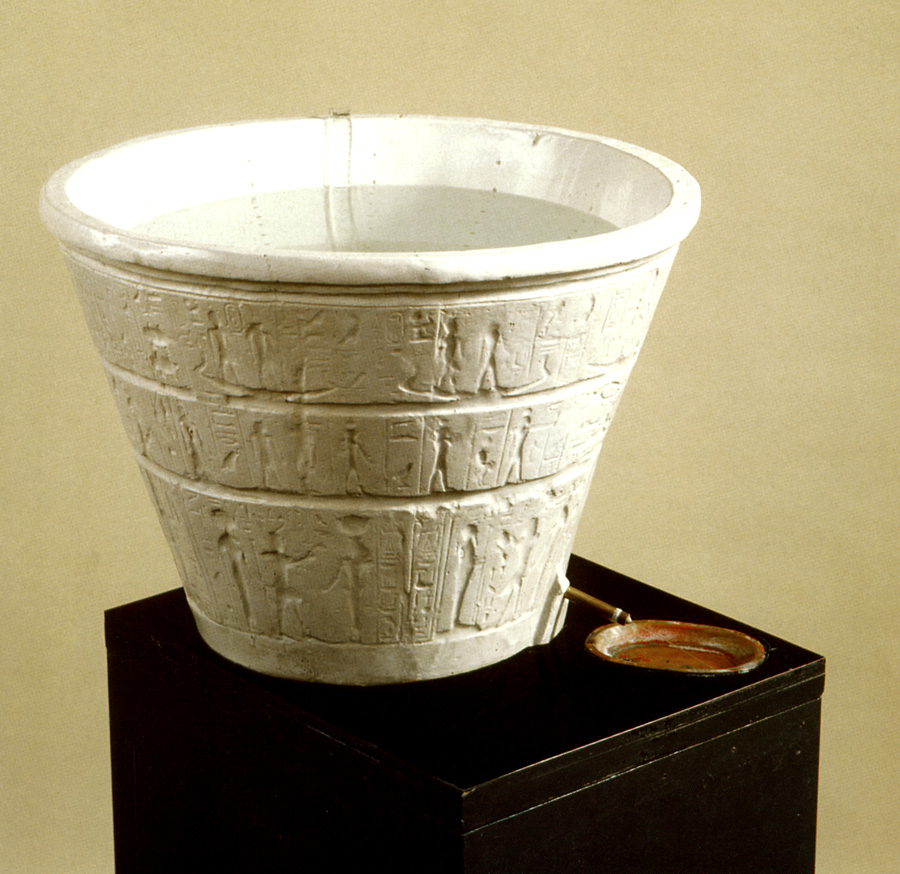The project used 3-D-scans of preserved water clocks to measure and to analyse these genuine testimonies of ancient technology in detail with reference to their development and their functionality in a previously unique way.
Research

Reconstruction of an Egyptian Clepsydra from the Temple of Karnak | Source: L. von Mackensen, Neue Ergebnisse zur ägyptischen Zeitmessung. Die Inbetriebnahme und Berechnung der ältesten erhaltenen Wasseruhr, Alte Uhren 1, 1978, ohne Seitenangabe.
When researching the question of time in antiquity, the technical capability of measuring time is one of the first issues one should look at. As part of the research group (A-3-) Water Management Anette Schomberg focused on the invention, the development and the dissemination of the water clock. This type of instrument was the first attempt to construct a time-measuring-device which would work independently from observation of the sun or stars. The outstanding success of this type of clock is proven through 3000 years of constant use and continued advancement – which ended only due to its substitution by the mechanical clock in the Middle Ages.
This is even more astonishing as even for the design of the simplest water clocks, a certain level of sophisticated technology was required. The use of water as a time indicator necessitates not only knowledge of water pressure and the ability to control its flow, but also factoring in such elements as cohesion and surface tension. This presupposes well-defined time units and a regularly structured calendar.
Although the famous Hellenistic clocks, like those of the Alexandrian engineer Ctesibios, only survived in descriptions and hardly left any traces in archaeological records, they usually stand in the focus of research. However, a hitherto often neglected group of preserved specimens – the so-called outflow clepsydrae – gives us the opportunity to gain real insight into ancient time measurement. Anette Schomberg’s research thus concentrates on these clepsydrae, which emerged in the middle of the first millennium BC. This type of water clock flourished in early Hellenistic time, were still in use by the Romans and have lastly been adopted by the Arabs in the Middle Ages.
Ever since the correct identification of these specimens as water clocks in the early 20th century, the question of their accuracy was a central issue of debate. In a groundbreaking study published in 1920, the famous Egyptologist Ludwig Borchardt argued that the water clocks did not work properly. The use of 3-D-models of the preserved outflow clepsydrae, has enabled Anette Schomberg to refute his argument. Instead of a more or less rough estimation, in combination with large scale reconstruction, as Borchardt has done, these models enabled her to measure and analyze the water clocks much more precisely, thus proving that his approach was incorrect.
Results
Results are published in two articles “To amaze the world – a contribution to the shape and meaning of the water clock in antiquity (2018)“ and “The clepsydra of Karnak and its successors- Egypt’s contribution to the invention of time measurement (2018)“.
Parts of the project have been presented at major international conferences and workshops, among them “16th Cura Aquarum In Greece 2015“, “International Water History Conference Delft 2016”, “Water Management in Ancient Civilisations, Topoi 2016” and “Temps et espace en Égypte ancienne/Time and Space in Ancient Egypt, Louvain-La-Neuve 2016”.
